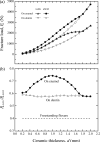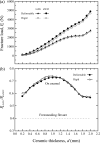Load-bearing properties of minimal-invasive monolithic lithium disilicate and zirconia occlusal onlays: finite element and theoretical analyses
- PMID: 23683531
- PMCID: PMC3698988
- DOI: 10.1016/j.dental.2013.04.004
Load-bearing properties of minimal-invasive monolithic lithium disilicate and zirconia occlusal onlays: finite element and theoretical analyses
Abstract
Objective: The aim of this study was to test the hypothesis that monolithic lithium disilicate glass-ceramic occlusal onlay can exhibit a load-bearing capacity that approaches monolithic zirconia, due to a smaller elastic modulus mismatch between the lithium disilicate and its supporting tooth structure relative to zirconia.
Methods: Ceramic occlusal onlays of various thicknesses cemented to either enamel or dentin were considered. Occlusal load was applied through an enamel-like deformable indenter or a control rigid indenter. Flexural tensile stress at the ceramic intaglio (cementation) surface-a cause for bulk fracture of occlusal onlays-was rigorously analyzed using finite element analysis and classical plate-on-foundation theory.
Results: When bonded to enamel (supported by dentin), the load-bearing capacity of lithium disilicate can approach 75% of that of zirconia, despite the flexural strength of lithium disilicate (400MPa) being merely 40% of zirconia (1000MPa). When bonded to dentin (with the enamel completely removed), the load-bearing capacity of lithium disilicate is about 57% of zirconia, still significantly higher than the anticipated value based on its strength. Both ceramics show slightly higher load-bearing capacity when loaded with a deformable indenter (enamel, glass-ceramic, or porcelain) rather than a rigid indenter.
Significance: When supported by enamel, the load-bearing property of minimally invasive lithium disilicate occlusal onlays (0.6-1.4mm thick) can exceed 70% of that of zirconia. Additionally, a relatively weak dependence of fracture load on restoration thickness indicates that a 1.2mm thin lithium disilicate onlay can be as fracture resistant as its 1.6mm counterpart.
Copyright © 2013 Academy of Dental Materials. All rights reserved.
Figures






Similar articles
-
Load-bearing capacity of lithium disilicate and ultra-translucent zirconias.J Mech Behav Biomed Mater. 2018 Dec;88:170-175. doi: 10.1016/j.jmbbm.2018.08.023. Epub 2018 Aug 21. J Mech Behav Biomed Mater. 2018. PMID: 30173069 Free PMC article.
-
Ultra-thin occlusal veneers bonded to enamel and made of ceramic or hybrid materials exhibit load-bearing capacities not different from conventional restorations.J Mech Behav Biomed Mater. 2019 Feb;90:433-440. doi: 10.1016/j.jmbbm.2018.09.041. Epub 2018 Sep 27. J Mech Behav Biomed Mater. 2019. PMID: 30447557
-
Load-bearing capacity and the recommended thickness of dental monolithic zirconia single crowns.J Mech Behav Biomed Mater. 2014 Jul;35:93-101. doi: 10.1016/j.jmbbm.2014.03.014. Epub 2014 Apr 2. J Mech Behav Biomed Mater. 2014. PMID: 24762856
-
Surface modification of zirconia or lithium disilicate-reinforced glass ceramic by laser texturing to increase the adhesion of prosthetic surfaces to resin cements: an integrative review.Clin Oral Investig. 2023 Jul;27(7):3331-3345. doi: 10.1007/s00784-023-05016-z. Epub 2023 Apr 17. Clin Oral Investig. 2023. PMID: 37069409 Free PMC article. Review.
-
Effect of different ceramic systems on antagonist dental structure by microtomographic analysis.Dent Mater. 2024 Jan;40(1):118-123. doi: 10.1016/j.dental.2023.10.021. Epub 2023 Nov 7. Dent Mater. 2024. PMID: 37940499 Review.
Cited by
-
Fracture resistance of bonded ceramic overlay restorations prepared in various designs.Sci Rep. 2022 Oct 5;12(1):16599. doi: 10.1038/s41598-022-21167-7. Sci Rep. 2022. PMID: 36198863 Free PMC article.
-
Monolithic zirconia crowns: effect of thickness reduction on fatigue behavior and failure load.J Adv Prosthodont. 2021 Oct;13(5):269-280. doi: 10.4047/jap.2021.13.5.269. Epub 2021 Oct 27. J Adv Prosthodont. 2021. PMID: 34777717 Free PMC article.
-
Substrate Rigidity Effect on CAD/CAM Restorations at Different Thicknesses.Eur J Dent. 2023 Oct;17(4):1020-1028. doi: 10.1055/s-0042-1757910. Epub 2022 Dec 13. Eur J Dent. 2023. PMID: 36513340 Free PMC article.
-
In-vitro performance and fracture strength of thin monolithic zirconia crowns.J Adv Prosthodont. 2018 Apr;10(2):79-84. doi: 10.4047/jap.2018.10.2.79. Epub 2018 Apr 18. J Adv Prosthodont. 2018. PMID: 29713427 Free PMC article.
-
Influence of CAD/CAM milling, sintering and surface treatments on the fatigue behavior of lithium disilicate glass ceramic.J Mech Behav Biomed Mater. 2021 Jan;113:104133. doi: 10.1016/j.jmbbm.2020.104133. Epub 2020 Oct 7. J Mech Behav Biomed Mater. 2021. PMID: 33049621 Free PMC article.
References
-
- Edelhoff D, Sorensen JA. Tooth structure removal associated with various preparation designs for anterior teeth. The Journal of Prosthetic Dentistry. 2002;87:503–9. - PubMed
-
- Edelhoff D, Sorensen JA. Tooth structure removal associated with various preparation designs for posterior teeth. The International Journal of Periodontics & Restorative Dentistry. 2002;22:241–9. - PubMed
-
- Beier US, Kapferer I, Burtscher D, Dumfahrt H. Clinical performance of porcelain laminate veneers for up to 20 years. The International Journal of Prosthodontics. 2012;25:79–85. - PubMed
-
- Petridis HP, Zekeridou A, Malliari M, Tortopidis D, Koidis P. Survival of ceramic veneers made of different materials after a minimum follow-up period of five years: a systematic review and meta-analysis. The European Journal of Esthetic Dentistry. 2012;7:138–52. - PubMed
-
- Pippin DJ, Mixson JM, Soldan-Els AP. Clinical evaluation of restored maxillary incisors: veneers vs. PFM crowns. Journal of the American Dental Association. 1995;126:1523–9. - PubMed
Publication types
MeSH terms
Substances
Grants and funding
LinkOut - more resources
Full Text Sources
Other Literature Sources

